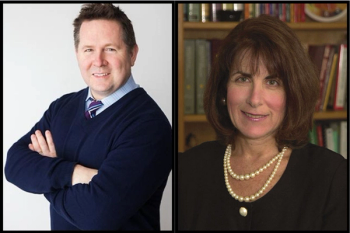
Treatment With Adjuvant Atezolizumab Yields Improved Outcomes in Stage II-IIIA PD-L1–Positive NSCLC
Patients with stage II to IIIA non–small cell lung cancer experienced an improvement in disease-free survival and time to locoregional and distant relapse after being treated with adjuvant atezolizumab.
Treatment with adjuvant atezolizumab (Tecentriq) vs best supportive care (BSC) resulted in improved disease-free survival (DFS) and time to locoregional and distant relapse in those with stage II to IIIA PD-L1–positive non–small cell lung cancer (NSCLC), according to an exploratory analysis from the phase 3 IMpower010 trial (NCT02486718) presented during the
The data, which were also published in The Lancet, showed that atezolizumab extended the DFS benefit in patients in the all-randomized stage II to IIIA population with PD-L1 expression on at least 50% of tumor cells (TC), including those with EGFR and ALK aberrations (n = 1005; HR, 0.43; 95% CI, 0.27-0.68) and without (HR, 0.43; 95% CI, 0.26-0.71).2
Furthermore, in a post-hoc descriptive analysis, investigators studied the time from randomization to relapse. In those with PD-L1 expression on 1% or higher of TC, the median time to any relapse was 17.6 months (95% CI, 0.7-42.3) with atezolizumab vs 10.9 months (range, 1.3-37.3) with BSC, appearing to delay recurrence in this subset with the PD-L1 inhibitor.
“The greatest magnitude of disease-free survival benefit was observed in those patients with PD-L1 in at least 50% of tumor cells,” lead study author Enriqueta Felip, MD, head of the Thoracic and Head and Neck Cancer Unit of Vall d’Hebron University Hospital, Vall d’Hebron Institute of Oncology, in Barcelona, Spain, reported in a virtual presentation. “At this DFS interim analysis, similar patterns of relapse were seen between the study arms, and time to relapse appeared to favor atezolizumab vs best supportive care in the group of patients with stage II to IIA, PD-L1–positive tumors.”
Up to 60% of patients with stage I to III NSCLC experience relapse even following curative intent treatment, creating a clear unmet need. In August 2021, the FDA granted a priority review designation to atezolizumab as an adjuvant treatment following surgery plus platinum-based chemotherapy in patients with NSCLC whose tumors harbor PD-L1 expression of 1% or higher per an FDA-approved test.3
The decision is supported by the IMpower010 data, which previously showed that adjuvant atezolizumab induced a 34% reduction in the risk of disease recurrence or death vs (HR, 0.66; 95% CI, 0.50-0.88; P = .004) in patients with stage II to IIIA disease and a PD-L1 tumor expression of 1% or higher.4
In the phase 3 trial, 1280 patients with completely resected stage IB to IIA NSCLC per Union for International Cancer Control/American Joint Committee on Cancer version 7 received cisplatin plus pemetrexed, gemcitabine, docetaxel, or vinorelbine for 1 to 4 cycles. Then, 1005 patients were randomized 1:1 to receive either 1200 mg of atezolizumab every 21 days or BSC.
Patients had to have an ECOG performance status of 0 or 1, must have undergone a lobectomy or pneumonectomy, and had tumor tissue available for PD-L1 analysis. Stage IB tumors had to be at least 4 cm in size.
Stratification factors included sex (male vs female), disease stage (IB vs II vs IIIA), PD-L1 tumor expression status (TC2/3 and any immune cell [IC] vs TC0/1 and IC2/3 vs TC0/1 and IC0/1).
The primary end points were investigator-assessed DFS tested hierarchically in patients with a PD-L1 tumor cell expression of at least 1% or higher, all randomized patients with stage II to IIIA disease, and the intent-to-treat (ITT) population of patients who have stage IB to IIIA disease. Secondary outcome measures included OS in the ITT population, DFS in those with PD-L1 TC expression of 50% or higher and stage II to IIIA disease, as well as 3- and 5-year DFS rates in all 3 patient populations.
The median patient age was 62 years (range, 26-84), and 38.0% were at least 65 years old. A total 66.9% of patients were male, 73.4% were White, and 55.3% had an ECOG performance status of 0; 65.6% of patients had nonsquamous histology. Additionally, 12.2% of patients had stage IB disease, and 54.6% had a PD-L1 tumor cell expression of 1% or higher.
In the data presented at the 2021 ASCO Annual Meeting, at a median follow-up of 32.2 months (range, 0.57-5), the median DFS in the all-randomized stage II to IIIA population in the investigative and control arms was 42.3 months (95% CI, 36.0–not estimable [NE]) vs 35.3 months (95% CI, 30.4-46.4), respectively (HR, 0.79; 95% CI, 0.64-0.96; P = .02).
In the ITT population, the median DFS with atezolizumab (n = 507) was NE (95% CI, 36.1–NE) vs 37.2 months (95% CI, 31.6–NE) with BSC (HR, 0.81; 95% CI, 0.67-0.99; P = .04).
The findings presented at the 2021 ESMO Congress focused on time to relapse and subsequent treatment in these patient populations.
Additional DFS results by PD-L1 status showed that, for patients in the all-randomized stage II to IIIA population (n = 882) with PD-L1–positive tumors (TC 1%-49%), including those with EGFR and ALK abnormalities (n = 247), the benefit with atezolizumab was smaller (HR, 0.87; 95% CI, 0.60-1.26). DFS outcomes with atezolizumab were similar in the patient subgroup who did not have EGFR or ALK abnormalities (HR, 0.82; 95% CI, 0.54-1.25). The EGFR- and ALK-excluded group (n = 743) was part of a post-hoc exploratory analysis, Felip explained.
“Now we know that probably these patients [PD-L1 TC 1%-49%] are benefitting less from immunotherapy as monotherapy,” she said.
An exploratory analysis evaluated the incidence of disease relapse, with disease recurrence as the sole event for DFS. In the PD-L1 TC 1% or higher group, the disease relapse rates were 29.4% (n = 73/248) and 44.7% (n = 102/228) with atezolizumab and BSC, respectively. In all-randomized patients with stage II to IIIA disease, the atezolizumab arm had a 33.3% (n = 147/442) disease relapse rate compared with 43.0% (n = 189/440) in the BSC arm. Finally, in the ITT population of stage IB to IIIA disease, the disease relapse rates were 30.8% and 40.8% with atezolizumab (n = 156/507) and BSC (n = 203/498), respectively.
Overall, there were no clear differences in relapse patterns between the PD-L1 TC 1% or higher stage II to IIIA, all-randomized stage II to IIIA, and ITT stage IB to IIIA populations. Locoregional-only relapse occurred in 47.9% (n = 35/73) and 41.2% (n = 42/102) of atezolizumab- and BSC-treated patients, respectively, with PD-L1 TC 1% or higher stage II to IIIA disease. In comparison, those rates were 39.5% (n = 58/147) and 38.1% (n = 72/189), respectively, in the all-randomized stage II to IIIA population. In the ITT stage IB to IIIA population, these rates were 37.8% (n = 59/156) and 36.9% (n = 75/203), respectively.
Distant-only relapse rates were 38.4% and 39.2% with atezolizumab (n = 28/73) and BSC (n = 40/102), respectively, in the PD-L1 TC 1% or higher group. In the all-randomized stage II to IIIA subset, distant relapse occurred in 42.2% (n = 62/147) of atezolizumab-treated patients and 40.7% (n = 77/189) of BSC-treated patients; these rates were 42.9% with atezolizumab (n = 67/156) and 40.4% with BSC (n = 82/203) in the ITT stage IB to IIIA group.
“Please be aware that only 29% to 33% of the patients in the atezolizumab arm relapse vs 41% to 44% in the best supportive care arm,” said Felip.
When evaluating sites of relapse in the ITT stage IB to IIIA population, 17.3% of patients on atezolizumab (n = 156) experienced locoregional and distant relapse vs 18.7% of those on BSC. Felip noted that the overall patterns of the relapse sites in the PD-L1 TC 1% or higher stage II to IIIA and all-randomized stage II to IIIA populations were consistent with the ITT population.
In the post-hoc descriptive analysis of time to relapse, the delay was shorter in the all-randomized stage II to IIIA group vs the PD-L1–positive group, at a median 12.4 months (95% CI, 0.7-42.3) and 11.1 months (95% CI, 0.8-42.1) with atezolizumab and BSC, respectively. Similarly, in the ITT stage IB to IIIA subgroup, the median time to relapse was 12.3 months (95% CI, 0.7-42.3) with atezolizumab compared with 12.0 months (95% CI, 0.8-42.1) with BSC.
A closer examination of these rates in the PD-L1 TC 1% or higher group showed that the median time to locoregional and distant relapse was 24.0 months (range, 2.3-42.3; n = 9) with atezolizumab vs 5.3 months (range, 1.3-34.2; n = 17) with BSC. Central nervous system–only relapse occurred at a median 18.2 months (range, 0.7-35.5; n = 8) and 10.6 months (range, 4.0-24.1; n = 12) with atezolizumab and BSC, respectively.
“Please be aware of the small sample size of these analyses,” Felip cautioned. “There are no clear differences in the median time to relapse between the 2 treatment arms in the all-randomized stage II to IIIA population, and in the intent-to-treat population, including patients with stage IB disease.”
Systemic non-protocol anti-cancer treatment following relapse was also explored, which was found to be well balanced across the 3 arms of patients who received chemotherapy, TKI treatment, and targeted monoclonal antibody.
“As expected, more patients received immunotherapy in the best supportive care arm; approximately 32% of patients when compared to the atezolizumab arm, in which approximately 12% of the patients received immunotherapy at disease recurrence,” Felip added.
Furthermore, no differences were noted in the use of radiation or surgery as post-relapse treatments between the 2 treatment arms and across the 3 patient subgroups.
Longer follow-up is needed and may reveal differences in relapse patterns and treatment options in these patient populations, Felip concluded.
References
- Felip E, et al. IMpower010: Patterns of relapse and subsequent therapy from a Phase III study of atezolizumab (atezo) vs best supportive care (BSC) after adjuvant chemotherapy (chemo) in stage IB-IIIA non-small cell lung cancer (NSCLC). Presented at: 2021 ESMO Congress; September 16-21, 2021; virtual. Abstract LBA9.
- Felip E, Altorki N, Zhou C, et al. Adjuvant atezolizumab after adjuvant chemotherapy in resected stage IB–IIIA non-small-cell lung cancer (IMpower010): a randomised, multicentre, open-label, phase 3 trial. Lancet. Published online September 20, 2021. doi:10.1016/S0140-6736(21)02098-5
- US FDA grants priority to Roche’s Tecentriq as adjuvant treatment for certain people with early non-small cell lung cancer. News release. Roche. August 3, 2021. Accessed August 3, 2021. https://bit.ly/3jj5TXN
- Wakelee HA, Altorki NK, Zhou C, et al. IMpower010: primary results of a phase III global study of atezolizumab versus best supportive care after adjuvant chemotherapy in resected stage IB-IIIA non-small cell lung cancer (NSCLC). J Clin Oncol. 2021;39(suppl 15):8500. doi:10.1200/JCO.2021.39.15_suppl.8500
Newsletter
Stay up to date on recent advances in the multidisciplinary approach to cancer.































































































